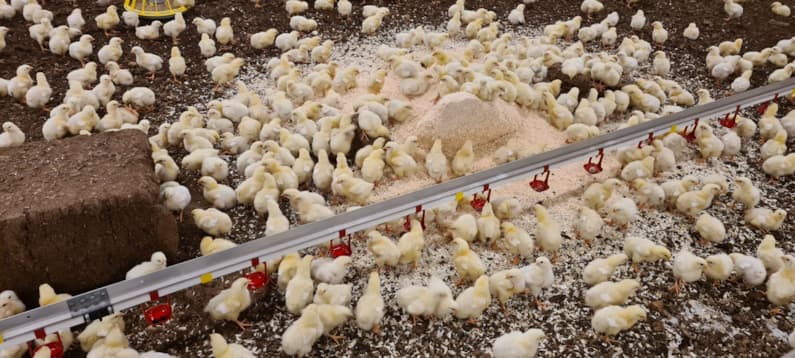The HKScan Agrofood Ecosystem® pilot uses artificial intelligence to monitor the behaviour of broiler chickens on Kariniemen Kotitila farm. According to the data of the two first flocks of birds, the activity level of broilers is maintained throughout the rearing period.
As part of HKScan’s responsibility, the Agrofood Ecosystem® work develops animal welfare and its monitoring with artificial intelligence and cameras. At the same time, transparency in primary production will be increased. In the pilot project, smart cameras were installed on the Kariniemen Kotitila farm at the beginning of January. Artificial intelligence is taught to identify the forms of natural behaviour in broilers from video material. In broilers, the key behavioural forms are considered to be pecking, i.e. food searching, bathing in litter and body care by preening.
Based on the behavioural data of the first and second flocks, it can be stated that the natural behaviour of broilers occurs throughout the rearing period. There are interesting variations in behaviours during different weeks. For example, chicks preen themselves more whereas older broilers prefer bathing and searching for food by scratching and pecking the litter.
“Through our farm-level pilot projects, we have new, advanced practical knowledge about animal behaviour. Together with the animal welfare experts of the Natural Resources Institute Finland, we were looking for information on the subject, but unfortunately couldn’t find a reliable ready-to-use method for monitoring the behaviour and activity of broilers. That’s why we decided open-mindedly to start developing such a method ourselves together with Empirica Finland Oy. The data shows that the broiler activity remains or even increases towards the end of the rearing period. This result also strengthens what broiler farmers themselves have observed while caring for the animals,” says Leena Pohjola, HKScan’s veterinarian.
Smart cameras following the broiler behaviour 24/7
Monitoring the welfare of animals always requires human eye. The advantage of smart cameras is that they can be used to monitor broilers and conditions even when the farmer is not present.
“We already have over 1,000 hours of video footage from the farm to analyse the behaviour of the broilers. The pilot utilises new technologies such as edge computing and artificial intelligence. With edge computing, the material can be processed on the farm and only the results are transferred over the network,” says Jan Borgelin, CEO of Empirica Finland Oy.
New enrichment
Data collection and modelling will continue on Kariniemen Kotitila farm. The third flock of birds in the pilot project was given new enrichment to the hall with the goal of further strengthening the natural behaviour.
“During my rounds in the broiler house, I have noticed that broilers are interested in new bales of cutter and moss and peat moss ramps. The bales first entice the broilers to climb and as the bales break down, pale cutter chips inspire them to bathe and scratch. Broiler chickens have had various enrichment in use even before, such as perches, shiny washers hanging on strings and floorball balls, and scales have served as swings. Litter containing pieces of wood and roots as well as the farm’s own grains added to compound feed also contribute to the realisation of the birds' natural behaviour, says the contract farmer Mikko Kiiski on the Kiiski farm.
You can follow the progress of the pilot and news from the Kiiski farm on the Kariniemen Kotitilan elämää blog (in Finnish)
Watch the video compilation from the broiler house (in Finnish)
Further information:
Leena Pohjola, veterinarian, HKScan tel. +358406484313, leena.pohjola@hkscan.com
Ulf Jahnsson, VP, Strategic development primary production, HKScan, tel. +358 400 784 193, ulf.jahnsson@hkscan.com
Media contacts:
HKScan Media Desk
communications(at)hkscan.com
tel. +358 10 570 5700

